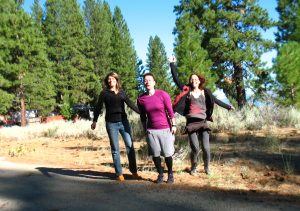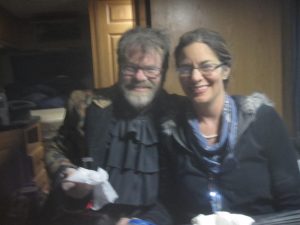Reflections: Minding the Gap
I just now gasped out loud as I calculated how long it’s been since I met and became friends with Patrick Ball—30 years. We met my first year at Columbia College, where he was already a seasoned activist and unpaid pain-in-the-neck to the administration. People Against Bad Things was his primary extracurricular passion; the ad hoc organization was alternately dubbed People For Good Things.
I leaned heavily toward liberal arts, and Patrick was a scientist through and through, but despite this gap in temperament, we’ve spent three decades enjoying stimulating debate. Little by little he’s invited me into his world, helping me dip my toe into topics that I otherwise might have avoided (ahem, statistics), as well as inviting me into conversations about evolutionary biology and the Great Spaghetti Monster in the Sky. I was a very proud student on the day I was able to challenge him on one of his assumptions: Patrick casually remarked to me that yoga seems to have a way of making people thin and fit; aha! I said, or is it that thin people are the ones drawn to yoga?
In 2012 I rendez vous’d with Patrick for my first Burning Man adventure and was able to meet Megan Price and Jule Krüger, two of his beloved colleagues from Benetech. I’d worked with them via email and teleconference over the summer as we prepared for their Burning Man research project: a census. This was the point at which I learned that most of us misuse the word “census.” Officially, a census is an enumeration of a population, meaning that each and every person is counted. Hah! The US government and the Burning Man Organization have something in common: both strive to do their best at estimating—not enumerating—populations by using random sampling, another term I learned that summer.
The census project was a huge hit. (One of the datasets we created dug into how many Burners vote in local and national elections, information that seems useful given how many policymakers want to shut down the event, in spite of the enormous revenue stream it provides. Not you, Harry Reid.)
Patrick waited just until after the event to make his pitch to me. The idea was that HRDAG would spin off into an independent nonprofit organization supported by a fiscal sponsor, and they invited me to be the communications arm of the new HRDAG team. I was flattered. Excited. A bit terrified? Patrick has, shall we say, exacting standards, and over the years I had witnessed a few meltdowns over work-related issues. I recalled a couple of vacation days in Amsterdam in 1999 with Patrick and our now ex-spouses, trying desperately to enjoy ourselves while something terrible was happening with Slobodan Milošević, whom Patrick went on to testify against in the International Criminal Tribunal for the Former Yugoslavia. (Unfortunately, the defendant died in 2006 before a verdict was reached, a phenomenon that Patrick refers to, with understandable bitterness, as “The Milošević Defense.”)
Megan was cool-headed, easygoing, and indisputably pleasant to be around. She also had this super-charming way of bouncing a little on her toes when she was excited about something, like, say, doing multiple systems estimation on subsets of populations. She uttered words like “strata” with such obvious glee that it was hard not to be carried along by her enthusiasm. Later I would get to meet Suzanne Nathans and Kristian Lum, who, along with Megan, are two of the dearest people I know. What luck, to work with these women. Pu pu pu, I should say if I were superstitious.
On February 1, 2013, HRDAG launched as an independent organization, and I’ve learned more about statistical science in these four years than I ever did in school, no contest. What I value most about my time at HRDAG is how it has changed the way I look at the world. Like most people, I used to look at a headline announcing a death toll, and I never questioned how that number was derived. Most likely, somewhere in my reptile math brain I assumed the bodies were counted, and that’s how we knew. It’s much, much trickier than that, though, isn’t it? Now, when I look at those flashy maps showing us how many are dying in which regions of a conflict-afflicted region I get skeptical: Where are those datapoints coming from? What about the regions where it’s too dangerous to collect data, how do we count casualties there? Are any of those casualties being double- or triple-counted because the data haven’t been de-duplicated? I’m not suggesting that all maps and data visualizations are bogus, but I am suggesting that some of them reflect responsible data analysis, while others do not.
One of the big lessons I’ve learned at HRDAG is that the things we don’t know can lead us astray from the truth. And in fact, by cleaving to what we do know, we can run afoul of the truth. It’s tricky, this business of seeking out what we don’t know, because we humans don’t always want to do that kind of hard thinking. Patrick, Megan, Kristian and the rest of the team, however, have been doing a great job evangelizing the message of paying attention to what we don’t know. They don’t seem to mind the hard thinking—in fact, they seem to like it.
Another big lesson is about bias. Guess what. It’s everywhere. Even in machines and algorithms. And that’s because it’s humans who are coming up with ideas about what to measure, coming up with ideas about how to measure them, and coming up with ideas about how to derive meaning from those measurements. What is an “idea,” if not a “bias” with a more mellifluous name? Working these last few years with Kristian on the Policing Project has been especially instructive in this area. The practice of predictive policing seems to be bias incarnate, a living, breathing example of what happens when humans invent technology but have the gall to assume that they’re not injecting their own humanity (i.e., bias) into the technology.
When I was young, I was arrogantly amused when older people would say things like, “The more I learn, the less I know.” Naturally, as I’ve matured, that old chestnut has become more meaningful to me. One of the things I’ve loved about working with HRDAG is that instead of being mystified by the universe of things we don’t know, or ignoring that universe, they use tools to tackle and get a better understanding of the mysteries. They use scientific methods to estimate what we don’t know, and I believe their estimates because they’ve had so much of their work validated.
You know how in the UK they say, “Mind the gap?” In science and politics, somebody has to mind the gap, and I’m so thankful that HRDAG does it so brilliantly.


